Abstract
Purpose
To evaluate the long-term surgical results of Ahmed glaucoma valve implantation (AGVI) and the effects of intra-cameral bevacizumab injection in neovascular glaucoma (NVG) after diabetic vitrectomy.
Methods
We reviewed the medical records of 57 patients with NVG after diabetic vitrectomy who underwent AGVI with or without intracameral bevacizumab injection. In each group, preoperative and postoperative intraocular pressure, the num-ber of glaucoma medications, and best corrected visual acuity (BCVA) were compared. We analyzed the rates of surgical success, postoperative complications, and risk factors.
Results
The cumulative probability of success was 87.7% at 1 year, 78.8% at 2 years, 70.5% at 3 years, and 61.6% at 5 years. Intraocular pressure and the number of glaucoma medications were significantly reduced and BCVA was sig-nificantly better at all postoperative follow-up time points in both groups. There were no differences in mean intraocular pressure, the number of glaucoma medications, BCVA, or the rates of surgical success between the two groups. The in-cidence of hypertensive phase was significantly reduced in the intracameral bevacizumab group, but neither the surgical success rate nor intraocular pressures were different compared with the control group.
References
1. The Diabetic Retinopathy Vitrectomy Study Research Group. Early vitrectomy for severe vitreous hemorrhage in diabetic retinopathy. Four-year results of a randomized trial: Diabetic Retinopathy Vitrectomy study report 5. Arch Ophthalmol. 1990; 108:958–64.
2. Shazly TA, Latina MA. Neovascular glaucoma: etiology, diagnosis and prognosis. Semin Ophthalmol. 2009; 24:113–21.

3. Aaberg TM, Van Horn DL. Late complications of pars plana vitre-ous surgery. Ophthalmology. 1978; 85:126–40.

4. Summanen P. Neovascular glaucoma following vitrectomy for dia-betic eye disease. Acta Ophthalmol (Copenh). 1988; 66:110–6.

5. Kumagai K, Furukawa M, Ogino N, et al. Long-term follow up of vitrectomy for diffuse nontractional diabetic macular edema. Retina. 2009; 29:464–72.
6. Kim HY, Yi KY, Chung H. Neovascular glaucoma after vitrectomy for proliferative diabetic retinopathy. J Korean Ophthalmol Soc. 1997; 38:2028–35.
7. Lee JH, Kwon SJ, Shin JP, et al. Neovascular glaucoma after vi-trectomy for proliferative diabetic retinopathy and the Ahmed valve implantation. J Korean Ophthalmol Soc. 2006; 47:1417–26.
8. Patel S, Pasquale LR. Glaucoma drainage devices: a review of the past, present, and future. Semin Ophthalmol. 2010; 25:265–70.

9. Schwartz KS, Lee RK, Gedde SJ. Glaucoma drainage implants: a critical comparison of types. Curr Opin Ophthalmol. 2006; 17:181–9.

10. Lee SH, Ma KT, Hong YJ. Outcome of Ahmed valve implantation in refractory glaucoma. J Korean Ophthalmol Soc. 2007; 48:83–90.
11. Souza C, Tran DH, Loman J, et al. Long-term outcomes of Ahmed glaucoma valve implantation in refractory glaucomas. Am J Ophthalmol. 2007; 144:893–900.

12. Lai JS, Poon AS, Chua JK, et al. Efficacy and safety of the Ahmed glaucoma valve implant in Chinese eyes with complicated glaucoma. Br J Ophthalmol. 2000; 84:718–21.

13. Topouzis F, Coleman AL, Choplin N, et al. Follow-up of the origi-nal cohort with the Ahmed glaucoma valve implant. Am J Ophthalmol. 1999; 128:198–204.
14. Huang MC, Netland PA, Coleman AL, et al. Intermediate-term clinical experience with the Ahmed Glaucoma Valve implant. Am J Ophthalmol. 1999; 127:27–33.
15. Shen CC, Salim S, Du H, Netland PA. Trabeculectomy versus Ahmed glaucoma valve implantation in neovascular glaucoma. Clin Ophthalmol. 2011; 5:281–6.
16. Netland PA, Ishida K, Boyle JW. The Ahmed Glaucoma Valve in patients with and without neovascular glaucoma. J Glaucoma. 2010; 19:581–6.

17. Park UC, Park KH, Kim DM, Yu HG. Ahmed glaucoma valve im-plantation for neovascular glaucoma after vitrectomy for pro-liferative diabetic retinopathy. J Glaucoma. 2011; 20:433–8.

18. Tripathi RC, Li J, Tripathi BJ, et al. Increased level of vascular en-dothelial growth factor in aqueous humor of patients with neo-vascular glaucoma. Ophthalmology. 1998; 105:232–7.

19. Eid TM, Radwan A, el-Manawy W, el-Hawary I. Intravitreal bev-acizumab and aqueous shunting surgery for neovascular glauco-ma: safety and efficacy. Can J Ophthalmol. 2009; 44:451–6.

20. Chalam KV, Gupta SK, Grover S, et al. Intracameral Avastin dra-matically resolves iris neovascularization and reverses neo-vascular glaucoma. Eur J Ophthalmol. 2008; 18:255–62.

21. Duch S, Buchacra O, Milla E, et al. Intracameral bevacizumab (Avastin) for neovascular glaucoma: a pilot study in 6 patients. J Glaucoma. 2009; 18:140–3.
22. Grisanti S, Biester S, Peters S, et al. Intracameral bevacizumab for iris rubeosis. Am J Ophthalmol. 2006; 142:158–60.

23. Shin JP, Lee JW, Sohn BJ, et al. In vivo corneal endothelial safety of intracameral bevacizumab and effect in neovascular glaucoma combined with Ahmed valve implantation. J Glaucoma. 2009; 18:589–94.

24. Kim YG, Hong S, Lee CS, et al. Level of vascular endothelial growth factor in aqueous humor and surgical results of Ahmed glaucoma valve implantation in patients with neovascular glaucoma. J Glaucoma. 2009; 18:443–7.

25. Li Z, Van Bergen T, Van de Veire S, et al. Inhibition of vascular en-dothelial growth factor reduces scar formation after glaucoma fil-tration surgery. Invest Ophthalmol Vis Sci. 2009; 50:5217–25.

26. Wand M, Madigan JC, Gaudio AR, et al. Neovascular glaucoma following pars plana vitrectomy for complication of diabetic retinopathy. Ophthalmic Surg. 1990; 21:113–8.
27. Lee JH, Kwon SJ, Shin JP, et al. Neovascular glaucoma after vi-trectomy for proliferative diabetic retinopathy and the Ahmed valve implantation. J Korean Ophthalmol Soc. 2006; 47:1417–26.
28. O’Neill EC, Qin Q, Van Bergen NJ, et al. Antifibrotic activity of bevacizumab on human Tenon’s fibroblasts in vitro. Invest Ophthalmol Vis Sci. 2010; 51:6524–32.
29. Ma KT, Yang JY, Kim JH, et al. Surgical results of Ahmed valve implantation with intraoperative bevacizumab injection in patients with neovascular glaucoma. J Glaucoma. 2012; 21:331–6.

30. Thieme H, Choritz L, Hofmann-Rummelt C, et al. Histopathologic findings in early encapsulated blebs of young patients treated with the Ahmed glaucoma valve. J Glaucoma. 2011; 20:246–51.

31. Krohne TU, Eter N, Holz FG, Meyer CH. Intraocular pharmacoki-netics of bevacizumab after a single intravitreal injection in humans. Am J Ophthalmol. 2008; 146:508–12.

32. Rojo-Arnao M, Albis-Donado OD, Lliteras-Cardin M, et al. Adjunctive bevacizumab in patients undergoing Ahmed valve im-plantation: a pilot study. Ophthalmic Surg Lasers Imaging. 2011; 42:132–7.

33. How A, Chua JL, Charlton A, et al. Combined treatment with bev-acizumab and 5-fluorouracil attenuates the postoperative scarring response after experimental glaucoma filtration surgery. Invest Ophthalmol Vis Sci. 2010; 51:928–32.

34. Kim DH, Park CK, Ahn MD. Clinical results of Ahmed valve im-plantation in the aspects of complications. J Korean Ophthalmol Soc. 2003; 44:888–95.
35. Ahn J, Woo SJ, Chung H, Park KH. The effect of adjunctive intra-vitreal bevacizumab for preventing postvitrectomy hemorrhage in proliferative diabetic retinopathy. Ophthalmology. 2011; 118:2218–26.

36. Park DH, Shin JP, Kim SY. Intravitreal injection of bevacizumab and triamcinolone acetonide at the end of vitrectomy for diabetic vitreous hemorrhage: a comparative study. Graefes Arch Clin Exp Ophthalmol. 2010; 248:641–50.

37. Ayyala RS, Zurakowski D, Smith JA, et al. A clinical study of the Ahmed glaucoma valve implant in advanced glaucoma. Ophthalmology. 1998; 105:1968–76.
38. Nouri-Mahdavi K, Caprioli J. Evaluation of the hypertensive phase after insertion of the Ahmed glaucoma valve. Am J Ophthalmol. 2003; 136:1001–8.

Figure 1.
Cumulative probability of the surgical success after Ahmed valve implantation for neovascular glaucoma after dia-betic vitrectomy. The figures under the horizontal axis indicate the number of patients that were followed up at that time.
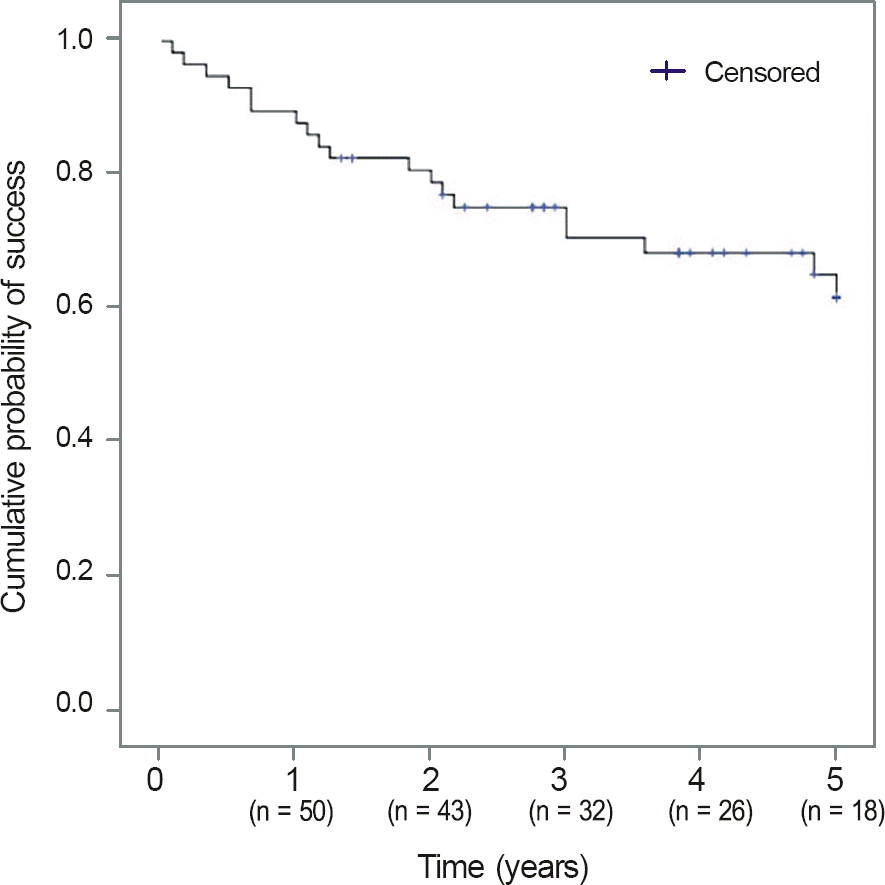
Figure 2.
Cumulative probability of the surgical success of the Avastin (Bevacizumab) group and the control group after Ahmed valve implantation for neovascular glaucoma after dia-betic vitrectomy. The figures under the horizontal axis indicate the number of patients that were followed up at that time (Avastin group/Control group). There was no statistically significant dif-ferences in success rate between the 2 groups ( p = 0.763).
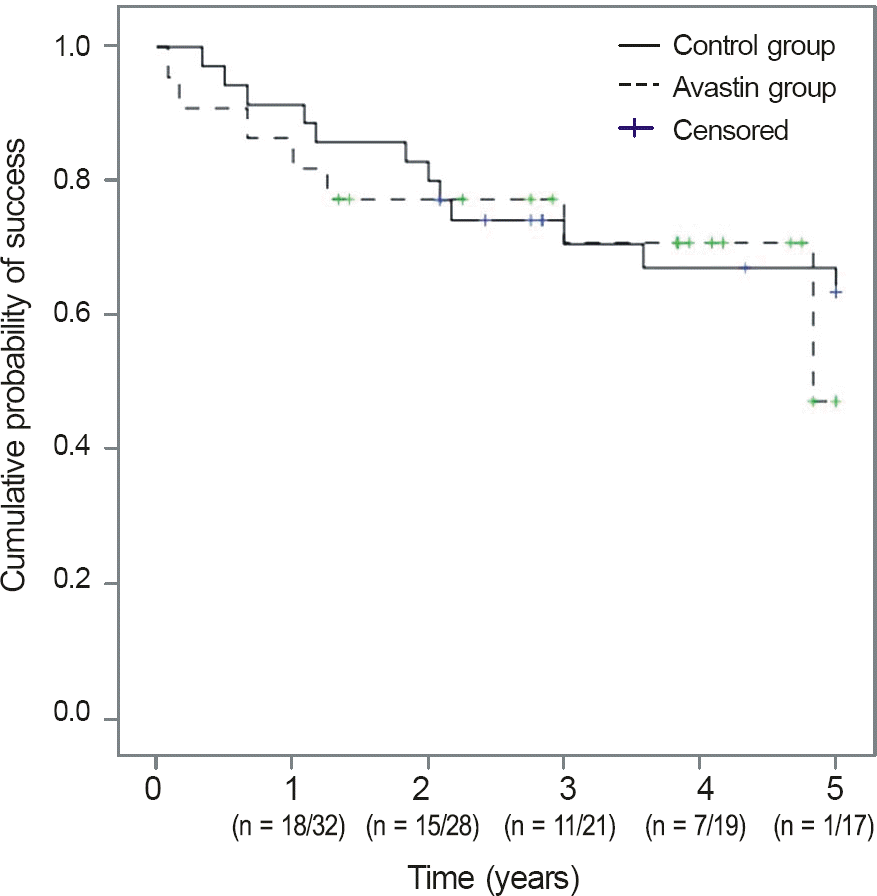
Figure 3.
Mean intraocular pressure changes of the Avastin group and the con-trol group after Ahmed valve implantation for neovascular glaucoma after diabetic vitrectomy. There was no statistically sig-nificant differences in the mean intraocular pressure between the 2 groups.
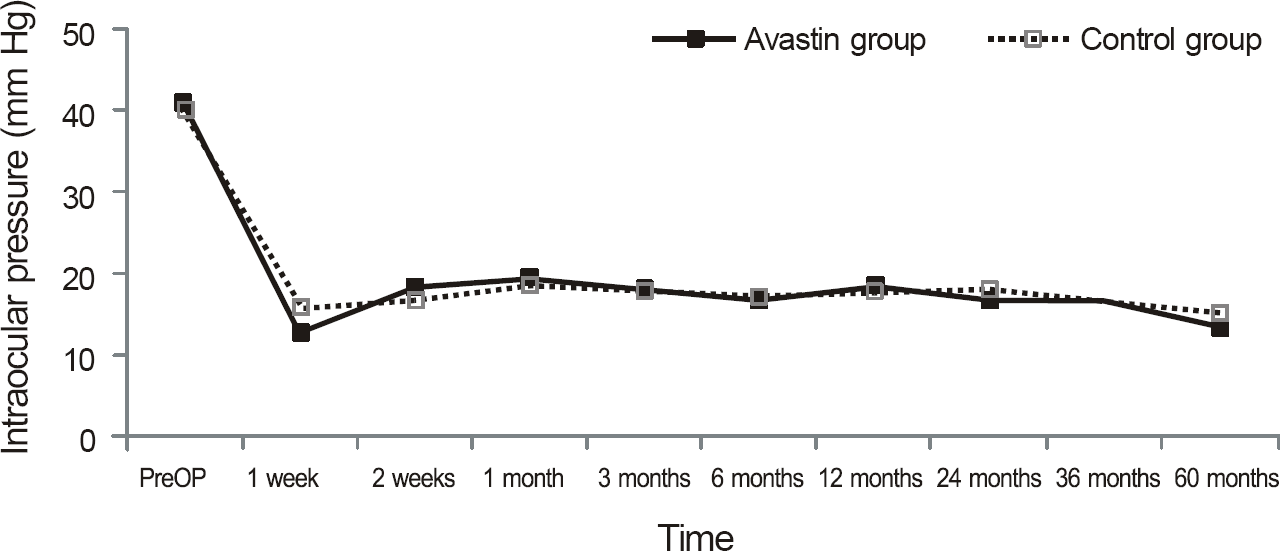
Figure 4.
Mean number of glaucoma medi-cations of the Avastin group and the con-trol group after Ahmed valve implantation for neovascular glaucoma after diabetic vitrectomy. There was no statistically sig-nificant differences in the mean number of glaucoma medications between the 2 groups.
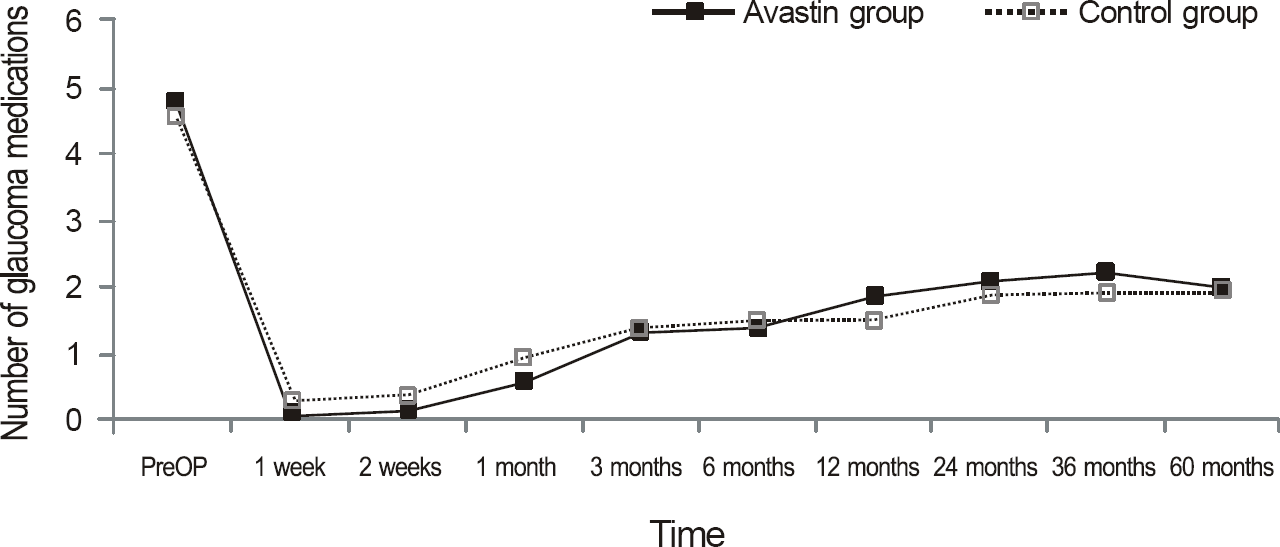
Figure 5.
Mean best corrected visual acui-ty (log MAR) changes of the Avastin group and the control group after Ahmed valve implantation for neovascular glauco-ma after diabetic vitrectomy. There was no statistically significant differences in best corrected visual acuity between the 2 groups.
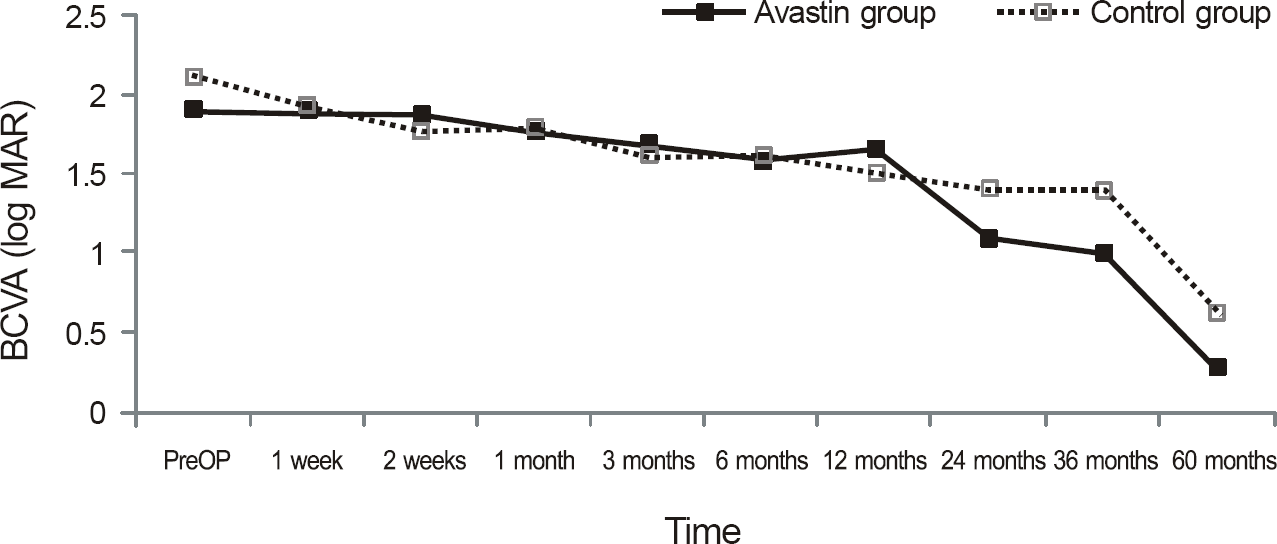
Table 1.
Preoperative data of the Avastin group and the control group
Values are presented as mean ± SD or n (%). DM = diabetes mellitus; IDDM = insulin dependent diabetes mellitus; NIDDM = noninsulin dependent diabetes mellitus; BCVA = best corrected visual acuity; log MAR = logarithm of minimum angle resolution; PRP = panretinal photocoagulation; NVG = neovascular glaucoma; SO = silicone oil.
Table 2.
The surgical complications and hypertensive phase of the Avastin group and the control group during follow-up after Ahmed valve implantation
Table 3.
Outcomes of univariate Cox proportional hazard regression model for surgical failure of Ahmed valve implantation
Table 4.
Outcomes of multivariate Cox proportional hazard regression model for surgical failure of Ahmed valve implantation




 PDF
PDF ePub
ePub Citation
Citation Print
Print


 XML Download
XML Download